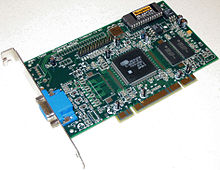Rambus Dynamic Random Access Memory

Rambus Dynamic Random Access Memory (RDRAM) is a type of synchronous DRAM that was developed by the US company Rambus Corporation.
Working principle
The Rambus solution consists of three components: Rambus controller, Rambus channel and RDRAM.
The Rambus architecture can manage several independent Rambus channels. The channel interface from Rambus contains a data bus that is only 16 or 18 bits (with ECC). The address bus is 8 bits wide and has separate lines for row and column control. Advantage: Simultaneous independent access to rows and columns is possible while data from the previous command is still being transferred.
Like DDR-SDRAM, the Direct RDRAMs (DRDRAM) use both signal edges for data transmission. In the course of a simplified naming, only the designation RDRAM is used today.
Each individual RDRAM IC has the full data width of the channel. Compared to 64-bit memory buses, however, the frequency of the channel must be correspondingly high in order to achieve competitive bandwidths.
In some architectures, the RDRAMs must be installed in pairs and any unused memory slots must be terminated with a CRIMM .
Data transfer
The internal data transfer of an RDRAM to the memory matrix differs significantly from the data width and timing of the channel: Internally, a 128-bit wide data path (144 bit with ECC) with a clock frequency of 100 MHz is used. This means that 128 bits can be transferred to and from the memory matrix every 10 ns - this corresponds to the channel transfer rate of 1.6 GByte / s. An internal RDRAM logic divides the data into 16-bit packets before they are transmitted to the bus via the I / O pins at the channel clock frequency of 800 MHz. Due to the full data width of the ICs, the data is not distributed over all components when accessed, but is stored together in a chip. Disadvantage: The chips become very hot during burst access, which requires additional cooling measures. Rambus modules are therefore provided with an additional cooling plate, which is supposed to ensure sufficient heat dissipation. Since the temperature of the cooling plates can exceed 60 ° C during normal operation, there is a corresponding warning on the modules, usually in the form of the warning sign "Warning of hot surface".
Each channel can manage up to 32 RDRAM chips. Interleaving with overlapping transfers between the chips and the Rambus controller increases the efficiency for a continuous data stream. In addition, there is the high number of banks in the individual RDRAMs. Up to 16 banks per IC can process commands in parallel and ensure high efficiency with heavy data traffic on the bus.
precursor
Before the development of Direct Rambus , with which this type of memory only became more widely known, there were already the forerunners Base Rambus and Concurrent Rambus , which were used in special graphics-heavy applications e.g. B. were used in workstations and game consoles.
Problems in the mass market
When the Pentium 4 (Willamette core) appeared, Intel stoically favored RDRAM as the successor to SDRAM . This was particularly evident from the fact that the chipsets for the Pentium 4 only offered RDRAM support. Although RDRAM had a higher burst transfer rate than SDRAM, it had a longer latency period and significantly higher power consumption, especially when fully equipped, and consequently produced a lot of waste heat, which, in contrast to SDRAM, was unevenly distributed across the chips. Furthermore, it was more than twice as expensive as SDRAM in the beginning. A PC system with an AMD Athlon processor and SDRAM had a similar performance as one with a Pentium 4 processor and RDRAM, but cost significantly less.
With the appearance of GDR SDRAM systems for the Athlon, the latter took the lead. Intel recognized the problems and in August 2001 also offered support for SDRAM-PC133 with the 845 chipset. In this context, the weakness of the Pentium 4 was revealed. It now ran in systems with SDRAM sometimes significantly slower than in systems with RDRAM. A short time later, however, Intel presented a revised version of the Pentium 4 (Northwood core), which now had a significantly larger cache ( second level cache ). This processor could now easily compete with the AMD Athlon XP in a DDR-SDRAM system, which means that the issue of RDRAM had also been dealt with for Intel . It was not until January 2002 that Intel supported DDR-SDRAM and thus offered useful memory support for the Pentium 4 beyond RDRAM.
Aside from the PC market, RDRAM was used in the Nintendo 64 and PlayStation 2 game consoles and occasionally in graphics cards (for example from Cirrus Logic ).
successor
As a successor, Rambus developed the XDR memory , which is used in the Playstation 3 and other devices with cell processors . The XDR technology offers several advantages compared to the GDDR standard. This should enable simpler boards and the bandwidth should also be significantly larger. While GDDR5 uses a 4 × multiplier, XDR has an 8 × multiplier. The further developed XDR2 standard comes to 16 ×.
See also
- Memory modules based on Rambus: RIMM and SO-RIMM
- XDR DRAM

